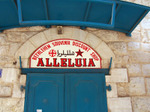In the cool of the evening, we ate our meal on a veranda set underneath a grape arbor. An enormous and perfectly full orange moon rode low in the sky over scrubby mauve hills. The air smelled of wood smoke. Everything was delicious, and we ate it all: freekeh soup—crushed barley and shredded chicken in an intense, chickeny broth; mezes that included tomato and cucumber salad; pickled carrots and celery and baby okra; little cheesy phyllo triangles; kibbe; silky hummus; eggplant salad made simultaneously sweet and sharp by tomato and citrus; and a tabbouleh that was essentially a sparkling-fresh parsley salad merely dotted with bulgur instead of the grain-heavy dish you normally find in the States. I was reminded that parsley is treated as a vegetable in the Middle East, and what an intelligent idea that is. We ordered more wine, caught our breath, and moved on to the mixed grill—chicken shashlik, lamb chops, and well-seasoned kebabs—and succulent chunks of lamb cooked with yogurt in a stew and served with saffron rice. Then we sat there, sipping our glasses of mint tea and gazing at the moon. "Back to Jerusalem tomorrow," someone said quietly.
That was where we had started our tour, of course, and no matter how you feel about religion, like all ancient cities it is haunted and heartbreaking. By the time we returned from Petra, things between Israel and Hezbollah had gotten very ugly indeed. Press and U.N. personnel were pouring into our hotel, the American Colony, and we were in the thick of things, which always makes me feel secure—forget the CNN channel; I'd rather have a drink with the reporter just in from Gaza whom I met in the hotel's unbelievably great bookshop. We had access to information from all points, and we took our cues from the people on the street: Life goes on. And being variously from New York City, Washington, DC, and New Orleans, we got the picture.
Here are some of our favorite things in Jerusalem and beyond. It's a very personal list and a pinhole view of a place with a great deal of metaphysical heft. We hope you go sometime.

Religious Sites
The Western Wall, the Dome of the Rock, and the church of the Holy Sepulchre are all astonishing and gratifying in their own ways. (One of my companions found the wall so powerful that he went back again and again. My other female companion and I had a different experience when shunted off to the women's section: We felt like second-class citizens.) Rather more off the beaten path is the church of Saint Mark (in the Armenian Quarter), the center of the tiny but valiant Syrian Orthodox community, whose services are conducted in Aramaic. Tradition has it that the building covers the house of Mary, Mark's mother; Saint Peter came here when he was released from prison by an angel (see the Rembrandt in the Israel Museum); the Virgin Mary was baptized here; and the Last Supper was eaten here. This is all of dubious authenticity, but the place has its own mystical reality. If you are lucky, a tiny woman dressed in black will show you the extraordinarily beautiful icon of Mary that hangs above the font. It is in the darkest corner of the dimly lit church, and the guide will light two long tapers and hold them up to dramatically illuminate the painting. Mesmerizing stuff, and you will either run screaming out into the street or be rocked back on your heels. A less debatable call from a historical point of view is the serene Garden of Gethsemane, on the Mount of Olives. The Mount of the Beatitudes, up on the Lake of Galilee, is even more contemplative; its tranquility is a balm to the weariest of travelers. The Church of the Nativity, in Bethlehem, was built by Constantine over the grotto where Jesus is said to have been born. "Bethlehem is charming and moving and strange," wrote Rose Macauley in The Towers of Trebizond. "I like the dark cavern glittering with silver lamps and gold and silver and tinsel ornaments and smoky incense fumes." She could have written that yesterday instead of in 1956. Mount Nebo, in Jordan, is one of the world's most powerful, primal, ancient liturgical sites. This is where the Moses saw the Promised Land stretching down toward the River Jordan and the Dead Sea. The landscape remains essentially unchanged, and if you have any imagination at all, you can easily transport yourself back 2,000 years. Read Martin Luther King Jr. as well as Deuteronomy while standing on the windy outcrop.


 Pinterest
Pinterest


